The Pentacon six TL Camera
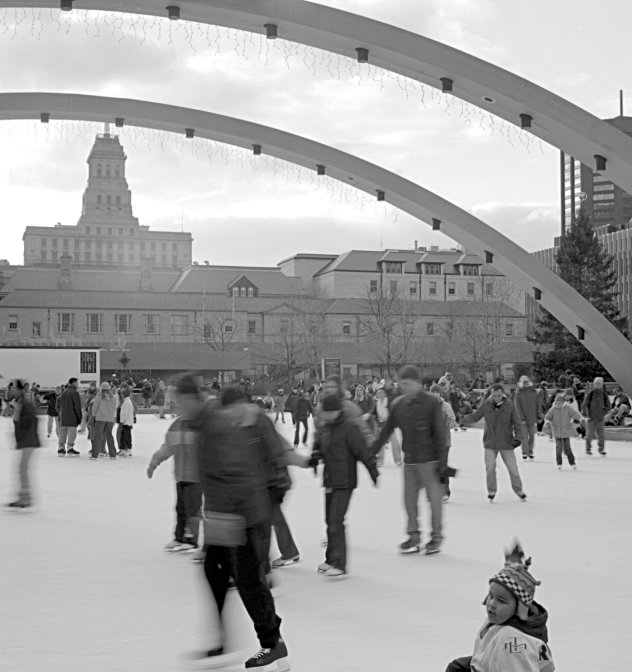
The Pentacon six TL is an affordable medium-format camera, widely available on the used market.
Pros
- cheap; a good used outfit (body, standard lens, metering prism) is less than US$200. The standard lens (Carl Zeiss Jena 80mm f/2.8 MC Biometar) is very sharp, and gives pleasing results.
- large 6x6 frame size scans well.
- great range of lenses, from full-frame fish-eye to 250mm+, interchangeable with (recent) Exakta 66, Kiev 60 and Kiev 88CM. Lenses are still made by Arsenal Kiev in Ukraine, and used lenses were made by Carl Zeiss Jena and Jos. Schneider.
- huge range of accessories such as metering prisms, extension tubes/bellows, focus magnifiers, and focusing screens.
- solid, all-metal construction.
- quite quiet.
- fast handling; like a large 35mm SLR.
- accurate and sensitive TTL prism option. Uses a bridge circuit, so can use pretty much any battery that will fit the compartment.
Cons
- no longer made; you have to rely on the used market.
- can have frame advance/spacing problems; requires careful loading and handling.
- no instant-return mirror, so no framing without winding on.
- heavy (especially with TTL prism).
- TTL prism is not coupled, and is quite dark when using the standard focusing screen.
Where to Buy
I bought mine directly from George Casey of Praha Camera (eBay: praha_camera). Other people I have dealt with are:
There are many other sellers of Pentacon six and compatible equipment. You're looking for an outfit that has had a CLA (clean, lubricate, adjust) and/or a good return policy.
Links
- TRA's excellent Pentacon six System pages at pentaconsix.com give a good overview of the system. The film loading tips are essential.
- Nathan Dayton's Communist Cameras, http://www.commiecameras.com, describes all the available parts in detail.
- Since the lenses are interchangeable with some Kiev cameras, Kevin Ing's Kievaholic Klub, http://kievaholic.com, has some useful tips
- Carlos Alvarez's Kiev 88 mailing list, http://groups.yahoo.com/group/Kiev88, doesn't mind Pentacon six queries.
Medium Format On A Budget Productions present …
Make your own 120 Film Cans
I've often wondered why the relatively tough little metal-clad 35mm roll comes in a neat plastic case, while the bigger and more delicate 120 roll has nothing more than foil to protect it. You can buy 120 film cans, but they are expensive after-market things.
Since I also shoot 35mm, I tend to end up with a lot of empty film cans. Some brands of film, I noticed, have quite different can diameters. Fuji seems to have the narrowest, Ilford next, and then Agfa the widest. A Fuji can slips quite neatly inside an Agfa can — in fact, if you bore a small hole in the bottom of an Agfa, fill it with water, and slide a Fuji can in as a plunger, it acts as quite an effective single-shot water pistol. But I digress …
But best of all, I discovered that a Fuji can is a tight interference fit into an Ilford can. Since I knew that a 120 spool is a smaller diameter than a 35mm roll, and is less than twice the length, I knew I could do something with this.
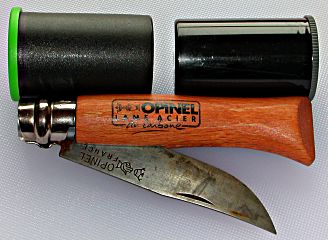 You
will need:
You
will need:
- an Ilford film can. It doesn't need to have a lid, as it will be acting as the base of the "stretch" 120 can.
- a Fuji film can. I've only used the black kind you get with the faster films. I suspect that the clear cans that are used on the rest of the range might work, but won't be light-tight.
- a sharp knife. The pictured Opinel may not look much, but it has a razor-like carbon steel blade.
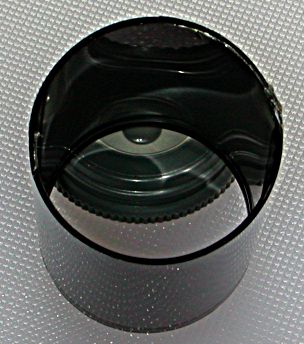 Slice the
end off the Fuji can. It helps to poke a hole in the side of the can a
couple of millimetres up from the end, and then start slicing where
you made the hole.
Slice the
end off the Fuji can. It helps to poke a hole in the side of the can a
couple of millimetres up from the end, and then start slicing where
you made the hole.
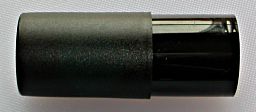 Jam the now
baseless Fuji can into the Ilford can, and push it down to the desire
length. It really helps if you take the lid off the Fuji can, as
otherwise you'd be working against air compression. It also helps if
you have a spare 120 spool handy, to check that you haven't pushed the
two cans too far in to be useful.
Jam the now
baseless Fuji can into the Ilford can, and push it down to the desire
length. It really helps if you take the lid off the Fuji can, as
otherwise you'd be working against air compression. It also helps if
you have a spare 120 spool handy, to check that you haven't pushed the
two cans too far in to be useful.
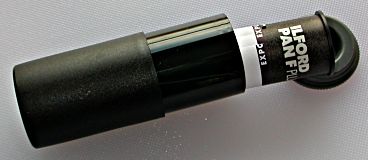 And there
you are! It might be rather rough and ready, but it works. I don't
know how durable or waterproof these things are, but they'll afford
considerably more protection than having them rolling about loose in
your camera bag.
And there
you are! It might be rather rough and ready, but it works. I don't
know how durable or waterproof these things are, but they'll afford
considerably more protection than having them rolling about loose in
your camera bag.